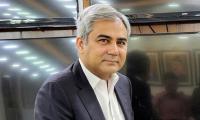In the era of regionalism, a combination of political and economic factors has prevented Pakistan, notwithstanding its strategic location, from significantly shoring up its trade relations with neighbouring counties.
Pakistan is a member of two regional blocs: the Economic Cooperation Organization (ECO) and the South Asian Association for Regional Cooperation (Saarc). Both these organisations have economic integration as one of their core objectives. Each bloc has a flagship preferential trading arrangement: the South Asian Free Trade Agreement (Safta) in case of Saarc and the ECO Trade Agreement (Ecota) – which has yet to come into effect – in the case of the ECO.
Afghanistan is the only other country in the region which is a member of both the ECO and Saarc. The only neighbouring country with which Pakistan does not share membership of a regional economic organisation is China. However, Pakistan has a free trade agreement (FTA) with China dating back to 2007. Hence, Pakistan’s regional trade can be analysed by dividing its trading partners into the above-mentioned two blocs, while China may be dealt with separately.
Pakistan’s total annual trade with the seven other Saarc countries, including Afghanistan, is $5.19 billion. This includes $3 billion worth of exports from Pakistan and $2.19 billion worth of imports from the Saarc region. Pakistan’s global exports and imports are $22.08 billion and $43.98 billion, respectively, and, therefore, its total world trade is $66.06. The Saarc region accounts for 7.8 percent of Pakistan’s world trade, 13.5 percent of its world exports and 4.9 percent of its world imports.
Within Saarc, Pakistan’s major trading partners are India and Afghanistan. Pakistan’s total trade with India is $1.97 billion, including exports worth $0.312 billion to India and imports worth $1.66 billion from India. This gives India a 2.9 percent share in Pakistan’s global trade, a 1.41 percent share in global exports and a 3.7 percent share in global imports.
It is also evident from the data that, although Pakistan has not yet granted the most favoured nation (MFN) status to India, trade balance is heavily in favour of our eastern neighbour. This is hardly surprising since India, being a much bigger country, enjoys the economies of scale, has better economic indicators – such as savings and investment – and also has a much more diversified economy. At the same time, Pakistan accounts for less than one percent of India’s world trade. The abysmal Pak-India trade is one of the principal reasons for the ineffectiveness of Saarc.
During the PPP government (2008-13), Pakistan seemed to be on the course of normalising its trade relations with India. As part of the normalisation efforts, the positive list for trade with India was replaced with a negative list comprising some 1,200 products. However, there was no further headway towards conferring the MFN status on India.
Pakistan’s refusal to grant the MFN status to India can be attributed to both economic and political reasons. It is feared that opening up trade with India will expose the domestic industry to cheaper products from across the borders and thus balloon up the trade deficit.
Pakistan has historically linked the normalisation of economic and commercial relations with India to that of political relations – in particular the resolution of the Kashmir dispute – on the premise that perceived economic benefits will compel New Delhi to settle the political issues. A related argument is that granting the MFN status to India could weaken Pakistan’s Kashmir stance as well as the popular movement in the disputed territory.
Islamabad is not the only ‘bad guy’ when it comes to market access. Our exporters maintain that Pakistan-specific non-tariff measures (NTMs) in India restrict their access to the enormous Indian market. More than any other factor, these NTMs account for the low volume of Pakistan’s exports to India. The matter of the NTMs can be taken up with India as a quid pro quo for the MFN status. However, since the MFN issue is partly linked to non-trade issues, the quid pro quo seems to be a non-starter, especially at present when the Indo-Pak relations are at their low-water mark.
Pakistan has a healthy trade turnover with Afghanistan – $2.11 billion, including exports worth $1.72 billion to Afghanistan and imports worth $0.390 billion from that country. Afghanistan is Pakistan’s third largest export market, accounting for nearly eight percent of its global exports. Being a landlocked country, Afghanistan has remained dependent on Pakistan, as well as Iran, for its overseas trade.
As in the case of India, political issues have cast a pall over Pakistan’s trade with Afghanistan as well. Both countries incessantly accuse each other of patronising anti-state elements. The tense bilateral relations led to the closure of the Pak-Afghan borders at Torkham and Chaman for two weeks between February and March. Even when the borders are open, heightened security measures slow down the movement of traffic.
Pakistan’s total trade with the nine other ECO countries is $2.92 billion, including exports worth $2.05 billion from Pakistan and imports worth $0.876 billion from the ECO region. The ECO region accounts for 4.4 percent of Pakistan’s global trade, 9.2 percent of global exports and 1.9 percent of global imports. However, if we exclude Afghanistan – which is also a member of Saarc – Pakistan’s total trade with ECO countries amounts to $0.816 billion.
After Afghanistan, Pakistan’s major trading partner in the ECO region is Turkey. The total bilateral trade is $0.440 billion, including exports worth $0.235 billion from Pakistan and imports worth $0.205 billion from Turkey.
With China, Pakistan’s bilateral trade is $12.94 billion (19.5 percent of Pakistan’s global trade) including exports worth $1.93 billion (8.7 percent of Pakistan’s global exports) from Pakistan and imports worth $11.01 billion from China (25 percent of Pakistan’s global imports). This shows that China has been a far greater beneficiary of the bilateral FTA than Pakistan. The adverse trade balance with China, as in case of India, is understandable and for more or less the same reasons. CPEC can be an instrument of significantly driving up bilateral trade. However, at least in the short run, the trade balance will further tilt in favour of China.
Cumulatively, Pakistan’s regional (ECO, Saarc and China) trade is $18.94 billion (28.6 percent of Pakistan’s global trade), including exports worth $5.26 billion (23.8 percent of Pakistan’s global exports) and imports worth $13.68 billion imports (31.1 percent of Pakistan’s global imports). Out of this, trade with China, India and Afghanistan is $18.94 billion or 89.8 percent of the total regional trade.
Recent developments have the potential to shore up Pakistan’s regional trade. One is the lifting of most of the international sanctions on Iran. The sanctions adversely affected Iran’s global trade, including its trade with Pakistan. The bilateral trade nosedived from $1.06 billion in 2010 to $0.293 billion in 2015.
The sanctions also rendered the Pak-Iran PTA, which has been in force since 2006, virtually ineffective. Pakistan is now negotiating an FTA with Iran. However, a word of caution is necessary. Pakistani banks are still hesitant to do business with their Iranian counterparts because of the continuing US sanctions. The sanctions made Iran largely a closed economy that will take some time to open up. The present government’s perceived tilt towards Saudi Arabia does not bode well for bilateral trade either. With the given circumstances and the current situation, any breakthrough in Pak-Iran trade in seems highly unlikely for now at least.
Second, Pakistan’s FTA with Turkey is likely to be concluded later this year and will enhance the exporters’ access to the Turkish market. However, since Turkey has a customs union with the EU, which binds more than 80 percent of its import tariffs – including most of the products of Pakistan’s export interest – it remains to be seen how much market access Turkey actually will provide to Pakistan. There is the possibility that Turkey will extract substantial concessions from Pakistan while providing only little in return.
The writer is a freelance countributor.
Email: hussainhzaidi@gmail.com
China stands ready to work with Pakistan to implement the important consensus reached by the leaders of both countries
The first thing is to build schools two kilometres apart on either side of the Indus
Theme for World Migratory Day 2024 focused on role and relationship of insects in our ecosystem for migratory birds
There is a prime minister but everyone, including him, knows that he has no mandate to sit on that high-backed chair...
There is also a need for reforms to ensure new trends are adopted and more preference is given to local industries,...
The most recent economic data provides a detailed and subtle view of Pakistan’s financial situation







